|
"Although gold in
the form of nuggets occurs in more than one section of the continent
north of Mexico, the tribes in general were practically without
knowledge of its use."---------1912,
Frederick Webb Hodge,
"Handbook Of American Indians North Of Mexico," p. 495.
"In later times, gold and silver were picked up
on the Florida coast from wrecked Spanish treasure ships, and the
Choctaw got silver by raiding the Caddo Indians after they had taken it
from the Spaniards."---------1957, Emma
Lila Fundaburk & Mary Douglass Fundaburk Foreman, "Sun circles And Human
hands," p. 35.
"In a few cases
objects of gold have been obtained from mounds in the Ohio valley,
notably in the Turner group, Hamilton County, Ohio, where a small copper
pendant was found retaining traces of a thin plating of gold, and bits
of the filmy sheet were also found in the debris."---------1912,
Frederick Webb Hodge,
"Handbook Of American Indians North Of Mexico," p. 495.
"Some rudely shaped and perforated gold beads
were found in one of the Etowah mounds and finds of slight importance
are reported from other localities." ---------1912,
Frederick Webb Hodge,
"Handbook Of American Indians North Of Mexico," p. 495.

NATIVE AMERICAN
INDIAN GOLD
LATE STONE AGE
Although gold does
occur in several areas of the United States, the use of gold by native
American Indians is almost unknown. There was no traditional use of
gold. In fact, where artifacts made of gold have been reported in the
U.S, the
largest percentage of them were apparently manufactured from European
shipwreck gold rather than from locally collected raw nuggets. The most
significant and recently dated artifacts have been discovered in burial mounds in
Florida. Most of these artifacts are believed to have been made from
looted Spanish gold that was retrieved from shipwrecks. But some of the
gold artifacts that have been found on mound sites in Ohio and Georgia
probably date to an
earlier period.
|
|
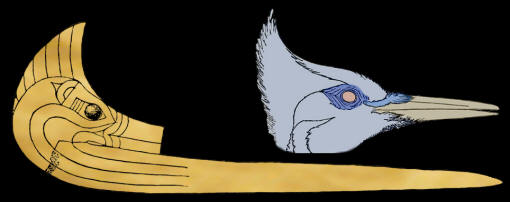
GOLD BIRD
MANATEE COUNTY, FLORIDA
EUROPEAN CONTACT
This artistic golden sculpture was discovered in 1877 in the center
of a mound in Manatee County, in southern Florida. It was discovered
in two pieces. The drawing is taken from a Smithsonian Annual Report
where it was described by Charles Rau. His description identified
the bird as an ivory billed woodpecker. It was cut from a thin piece
of gold plate that probably came from a Spanish shipwreck. It was
carved into the head of an ivory billed woodpecker on one end and an
elongated stylized neck of the bird that forms a knife-like blade on
the other end. The object was sent to the Smithsonian for study by
Damon Greenleaf. It measures 9 inches long and is one millimeter
thick. The metal is actually a gold silver alloy that contains 1.366
ounces of gold and .164 troy ounces of silver. The clerk of the
Bureau of Statistics at the Mint in Philadelphia calculated its
composition and weight. It's interesting to note that in 1877 the US
Mint gave its metal value as $28.45. |
|
|
Native American Indians were using three types of
malleable metals in the form of copper, silver and gold. The use of
gold and silver is insignificant when compared to the amount of copper
that was used. Over a period of several thousand years, Archaic,
Woodland and Mississippian people were making many different types of tools and ornaments
out of copper. Silver was used over a wide area in the eastern U.S. by
the Middle Woodland Hopewell, but only in very small amounts compared to copper. Gold was
the least used and is barely recorded in the archaeological record. |
|
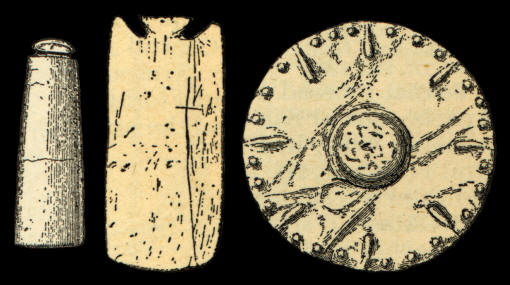
THREE GOLD OBJECTS
SUMTER & ORANGE COUNTIES, FLORIDA
EUROPEAN CONTACT
These three drawings are taken from an old Smithsonian Annual Report
that describes them as two gold pendants and one gold disc. They
were probably all made from Spanish gold that was retrieved from
shipwrecks. The pendant on the left is reported to have been found
in a mound in Sumter County, Florida. It's shape is long and narrow
with straight sides and bottom and convex on one face and flat on
the other. It measures 2 3/4 inches long and is grooved on one end.
The pendant in the center is from Orange County where it was found
with a burial in a mound. Its described as rectangular in shape and
corner-notched on one end. It was worn as a pendant along with
several glass beads that were also found with the burial. The disc
on the right was found in a mound in Orange County, Florida. It's
described as being 3 1/2 inches in diameter and made from a thin
sheet of gold with repousse dimples around the edge and a circle
design in the center. |
|
|
Early accounts, from Smithsonian reports, describe gold
artifacts that were found in mounds in Florida, Georgia and Ohio. But
these are few in number. Five artifacts are described from mounds in
Florida. The most interesting artifact is an object that was cut from a
thin piece of gold plate. The head of an ivory billed woodpecker is
carved on one end of an elongated stylized neck that extends outward to
form a
knife-like blade. The object was discovered in 1877 and sent to the
Smithsonian for study by Damon Greenleaf. It was found in the center of
a mound in Manatee County, in southern Florida and recovered in two
pieces. It measures 9 inches long and is one millimeter thick. The metal
is actually a gold silver alloy that contains 1.366 ounces of gold and
.164 troy ounces of silver. The clerk of the Bureau of Statistics at the
Mint in Philadelphia calculated its composition and weight. It's
interesting to note that in 1877 the US Mint gave its metal value as $28.45. |
|
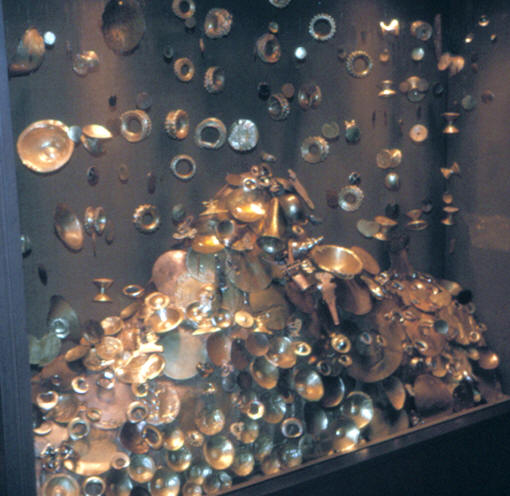
GOLD ARTIFACTS
GOLD MUSEUM
BOGOTÁ, COLUMBIA
This picture shows one of the display
cases in the Gold Museum in Bogotá, Columbia. The picture was taken
on a color slide many years ago. The display shows a wide array of
what appears to be mainly plates, bowls and bracelets. |
|
|
Two gold pendants are reported from Florida mounds. One
of the pendants was found in Orange County in a mound with a burial. Its
described as rectangular in shape and corner-notched on one end. It was
worn as a pendant along with several glass beads that were also found with the burial. Another pendant is
reported from a mound in Sumter County. It's shape is long and narrow
with straight sides and bottom and convex on
one face and flat on the other. It measures 2 3/4 inches long and is
grooved on one end. |
|

GOLD ARTIFACTS
GOLD MUSEUM
BOGOTÁ, COLUMBIA
None of the gold in the Gold Museum came from documented
excavations. Gerardo Reichel-Dolmatoff writes in "Goldwork And
Shamanism" that, "All we know is that they (the artifacts) were
removed from tombs and offering sites by "guaqueros" (tomb looters."
This picture shows another photograph that was taken in the Gold
Museum many years ago of another group of extraordinary golden
artifacts. |
|
|
Two gold discs are also reported from Florida mounds. They were
both found in Orange County. One is described as being 3 1/2 inches in
diameter and made from a thin sheet of gold with repousse dimples around
the edge and a circle design in the center. The other disc is described
as measuring 2 1/2 inches in diameter and made from a thin piece of
gold-silver alloy that has no decoration but is perforated in the
center. |
|
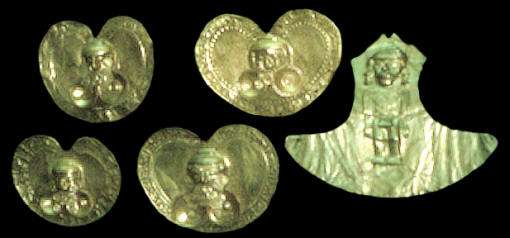
GOLD ARTIFACTS
GOLD MUSEUM
BOGOTÁ, COLUMBIA
More examples of gold artifacts from
the Gold Museum in Bogotá, Columbia. |
|
|
Early discoveries of a few gold beads have been reported from the
vicinity of the large mounds on the Etowah site in Barstow County. They
are described as rudely shaped and perforated and were probably made
from natural gold nuggets. Gold was first discovered in North Carolina
in 1799. Then discoveries of gold were made in Georgia, Alabama and
Virginia. Gold was mined continuously in Georgia from the 1820's through
1933. There are at least 500 old gold mines recorded in Georgia where nuggets
that weighed up to 54 ounces have been found. |
|
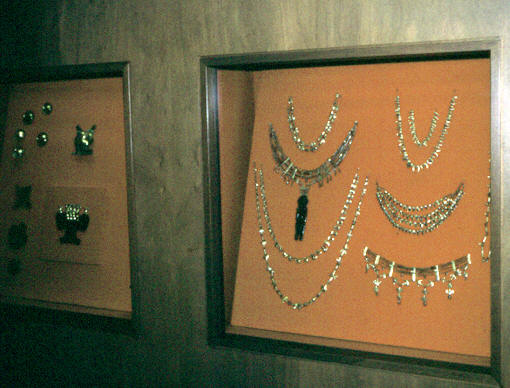
GOLD ARTIFACTS
GOLD MUSEUM
BOGOTÁ, COLUMBIA
This picture shows two more cases of
gold artifacts in the Gold Museum. The case on the right show
several exceptionally fine examples of necklaces. One necklace has a
large pendant in the shape of a human hanging in the center. |
|
|
Ohio has also produced a few objects made of gold. They are
reported from mounds in the Ohio Valley from the Turner group in
Hamilton, County. A copper pendant is reported to have been found that
had traces of a thin plating of gold. Moorehead is also reported to have
discovered some gold beads on another mound group. It's interesting to
note that the owner of the property was assured by Moorehead that there
was no gold or silver to be found there, but Moorehead was told to leave
after the owner discovered he did find some gold beads. |
|

GOLDEN RAFT
PRE-COLUMBIAN GOLD
A fine example of
pre-Columbian gold work. It depicts several people standing on a
raft. |
|
|
It might seem odd that gold was hardly ever used by native American
Indians. Especially when so many different countries and cultures around
the world have prized gold for so many different reasons. When compared
to other raw materials that were traded over long distances such as
copper, Obsidian, shells & mica, gold would have been much harder to find and collect.
It didn't serve any utilitarian purpose and there were no religious
connections with gold. So as a result the use of gold by native American
Indians was not traditional. Its use was just random and opportunistic. |
|
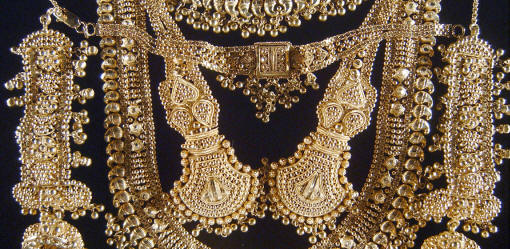
CLICK ON PICTURE FOR
LARGER IMAGE
INDIAN JEWELRY
INDIA
This picture shows a close-up view of some fine quality gold jewelry
from India. The India custom of wearing jewelry has an unbroken
history going back 5,000 years. Women traditionally accumulate
silver and gold jewelry as a form of monetary savings that can be
used in times of common disasters such as drought, food, famine,
political upheaval, etc. Different jewelry designs can identify
where a person comes from and even their status within the group. |
|
|
One of the world's greatest dramas was played out by the Europeans
search for gold in the New World. The Europeans intentions were made
clear from the beginning when Cortes tells Moctezuma's envoys that the
Spanish suffered from a strange malady for which the only cure was gold.
The Europeans search for wealth in the New World resulted in the death's of millions
of people, mostly from disease, and either destroyed or radically changed many large and
complex cultures forever. In 1492 Europe possessed approximately $200
million worth of gold and silver. By 1600 the amount increased to about
one billion six hundred thousand. An Aztec native commented that, "They thirsted
mightily for gold, they stuffed themselves with it, they starved for it,
and they lusted for it like pigs." |
|

POURING A GOLD BAR
SOUTH AFRICAN MINE
The people in this picture are demonstrating the
technique of pouring a gold bar. |
|
|
It's fortunate that gold wasn't used traditionally by native
American Indians. For if the reverse was true, archaeological sites
across the U.S. would have been dug up long ago. A Brazilian
native once asked, "Why are Kuben (Europeans) so hungry for gold?"
It's a question that's been repeated by native peoples in the New World
for hundreds of years. |
|
"REFERENCES"
1870,
Stephenson, M. F.,
"Account Of Ancient Mounds In General," Annual Report Of
The Board Of Regents Of The Smithsonian Institution,
pp. 280-381.
1877,
Rau, Charles,
"Observations On A Gold Ornament From A Mound In Florida,"
Annual Report Of The Board Of Regents Of The Smithsonian Institution,
pp. 298-302.
1912, Hodge, Frederick Webb, "Gold," Handbook Of American Indians
North Of Mexico, pp. 495-496.
1957, Fundaburk, Emma Lila & Foreman, Mary Douglass Fundaburk, "Sun circles And Human
hands," p. 35.
1984, Lea, Vanessa, "Brazil's Kayapo Indians Beset By A Golden
Curse," National Geographic, Vol. 165, No. 5. p. 675.
1988, Mack, John, "Ethnic Jewelry," pp. 65-66.
1991, Fagan, Brian, "Kingdoms Of Gold, Kingdoms Of Jade, The
Americas Before Columbus," p. 229.
2000, Reichel-Dolmatoff, Gerardo, (Goldwork And Shamanism, An
Iconographic Study Of The Gold Museum," p.17.
2003, Quilter, Jeffrey & Hoopes, John W., "Gold And Power In Ancient
Costa Rica, Panama, And Columbia," p.1.
Personal Communication with Brad Lepper.
|
|
RECENT
LISTINGS HOME
ORDERING |